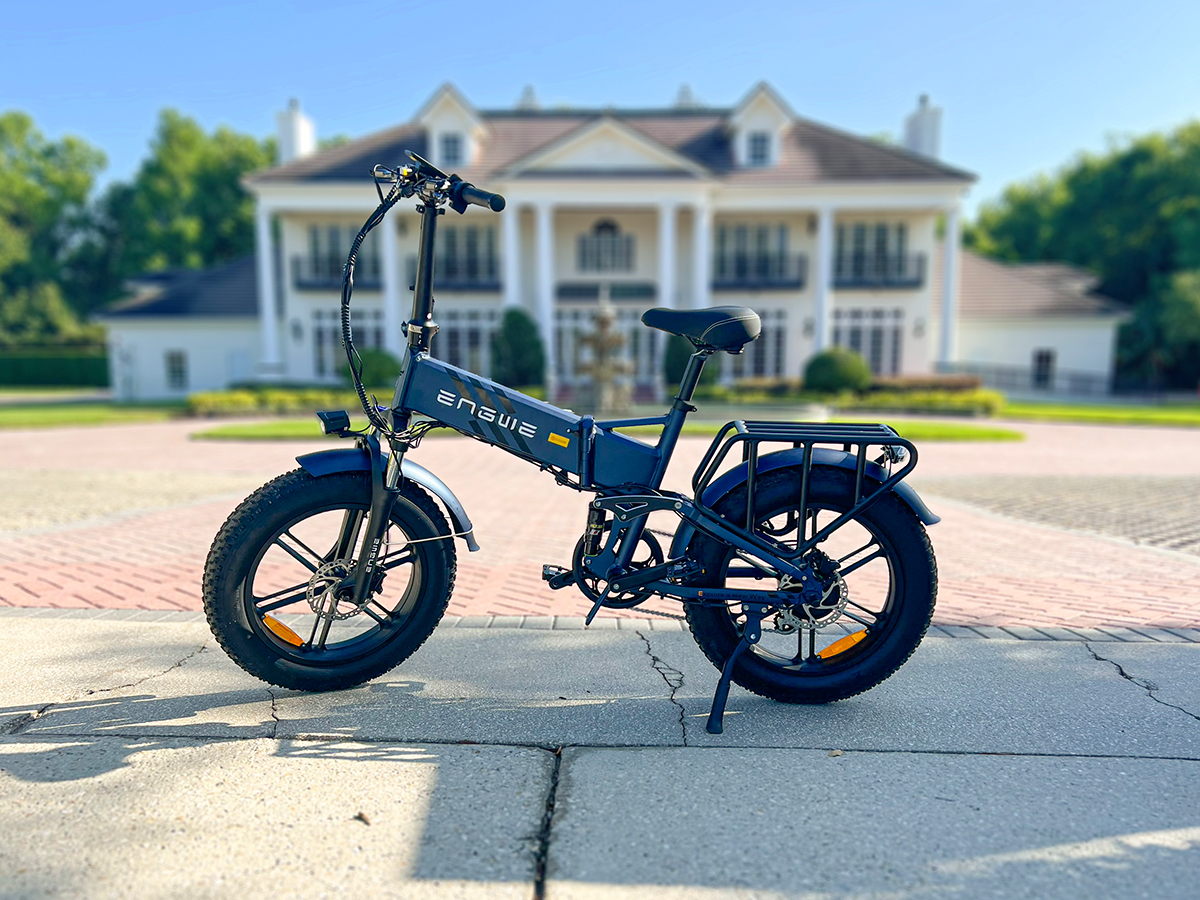
REVIEW – I’ve reviewed a few electric bikes now for The Gadgeteer. All four of my reviews thus far have been from four different manufacturers. The Engwe E26 All Terrain Fat Tire e-bike is my favorite of the four. It’s very well equipped, smooth and comfortable. One downside I didn’t mention in the review is that, over time, I’ve realized it’s a bit too large for my stature. I’m 5’-6” and the E26 is a big bike. When the Engwe Engine Pro 2.0 came up for review, my interest was piqued as it has 20” wheels. A little brother to the E26. The features of the Engine Pro 2.0 seemed to tick all the boxes for me, and I couldn’t wait to get it and put it through its paces.
What is it?
The Engwe Engine Pro 2.0 is a full-suspension, all-terrain e-bike. With its smaller, spoke-less wheels, it is more nimble and lighter weight. The 2.0 is an updated version of Engwe’s Engine Pro which came out a couple of years back. The 2.0 is updated in almost every way from the original Engine Pro. The Engine Pro 2.0 is a 20×4” Fat Tire e-bike with a 52v (updated from 48v), 16 Ah battery. The Engine Pro 2.0 has a 750W/1200W (peak) motor (upgraded from 750W/1000W peak) with good performance and plenty of power. The torque of the motor has also been updated to 750 Never mind (newton-meters) from 500 Nm. Going up hills, and taking off from a stand-still will be a little more effortless and quicker.
The pedaling sensor has been upgraded to a torque sensor from a cadence sensor. That means that the e-bike’s motor assists you according to the amount of effort you’re applying to the pedals. If you pedal harder, the motor helps you out a bit more. However, a torque sensor has one little annoying characteristic that will be mentioned later.
What’s included?
- Engine Pro 2.0 E-bike
- Metal front and rear fenders
- Headlight
- Rear rack
- 52V/16 Ah Lithium-Ion Battery
- 3A Battery Charger
- Assembly Tools
- Pedals
- 2 keys
- English User Manual
Tech specs
Click to expand
- Frame: Foldable, Aluminum alloy
- Tires Size: 20 x 4.0 inches
- Motor: 750w (rated)/1200w (peak) rear hub motor
- Torque: 75 N.m
- Battery: 52V/16 Ah Lithium-Ion Battery
- Max Speed: Throttle mode: 20MPH (32KPH) Pedal-assist mode: 28MPH (45KPH)
- Max Mileage: Throttle mode:30 Miles (48.3 KM) Pedal-assist mode: 68 Miles (109.4 KM)
- Brakes: 2-piston (per wheel) Hydraulic Disc Brakes (160 mm rotors)
- Transmission System: Shimano Altus 8 speed
- Suspension: Full with front fork and mid-frame Horst-link
- Display: Full color, high-brightness LCD
- Charging Time: about 6.5H
- Bike Weight: 69.6 lbs (31.6 kg)
- Gross Weight: 87.7 lbs (39.8 kg)
- Maximum Load: 330 lbs (149.4 kg)
- Rider Heights: 5.4-6.2 inches (165-190 cm)
Design and features
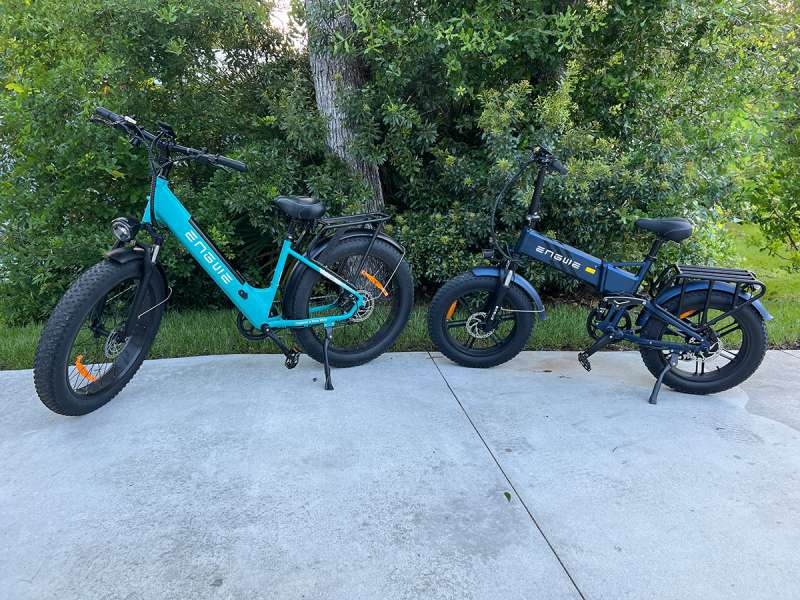
While assembling the Engwe Engine Pro 2.0 (see the next section for details), my excitement grew to get this thing out and ride it. Riding the big brother, the Engwe E26, was such a joy. I love that bike. However, since I’ve had the Engine Pro 2.0, my E26 buddy has been sitting all alone in the garage. I don’t know how to break it to the E26 that I found a new love. A new little buddy (Gilligan’s Island reference there for all of you over 40-year-olds).
Getting the Engine Pro 2.0 sized up for my liking was very easy with the easily adjustable handlebars and seat. Both come with quick-adjust clamps that don’t require any tools.
Riding the 2.0 with throttle only is quite exhilarating. Although the top speed is limited to 20 mph (32 kph), that was plenty fast for me. This is not the bike you want to buy if you have a need for speed. There are many other manufacturers and models out there to scratch that itch.
You can get the Engine Pro 2.0 up to 28 mph (45 kph) if you pedal on PAS level 5 (the highest level), in 8th gear (also the highest), going downhill, weigh a maximum of 165 lbs (75 kg), and have the wind at your back. I managed to get the e-bike to that top speed, and the motor definitely stopped providing assistance at 28 mph (45 kph). But that was OK. I do not like going that fast on a bike. I like the skin to remain on my body and not on the pavement or trail from wiping out.
One thing I did notice about the Engine Pro 2.0 is the motor is noisier at full power than other e-bikes I’ve reviewed. The motor on this bike is an upgrade from the last Engine Pro model. Its peak power is 1200 watts and it’s a 52V system, as opposed to the 1000-watt peak, and 48V system from the previous model. I’m sure these two factors contribute to the added sound from the motor. Usually on fat-tire e-bikes, the knobby tires make 90% of the noise as you glide across the pavement. The 2.0’s motor was louder than the tires at full power.
The 2.0 has a nice torque sensor that gives the perfect amount of pedal assist according to the amount of force being put down on the pedals. I do prefer it over the cadence-style sensor or many less-expensive e-bikes. One side-effect of a torque sensor is when standing still with the bike, with one foot on a pedal, the weight of your leg will cause the torque sensor to try to move the bike forward slightly. This can be a little disconcerting if you are at a crosswalk and the bike is trying to send you into traffic. All of this can be avoided by keeping one brake lever squeezed while you are stopped. I have yet to get in the habit of doing that.
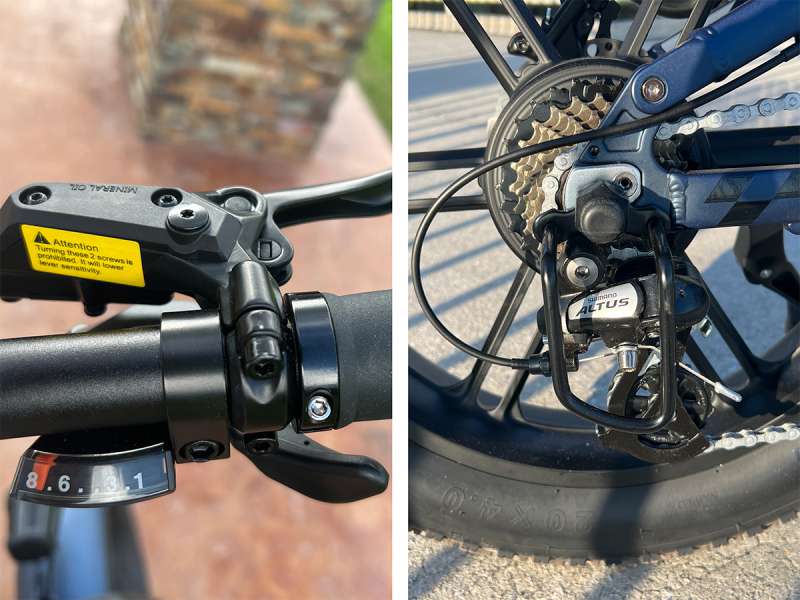
The Engine Pro 2.0 is equipped with an eight speed transmission and derailleur from Shimano. Switching gears is very easy with one lever for moving to higher gears and another lever for moving to a lower one. Not once during my review did the gear changes skip gears or bind in any way. Shimano equipment is fairly fool-proof.
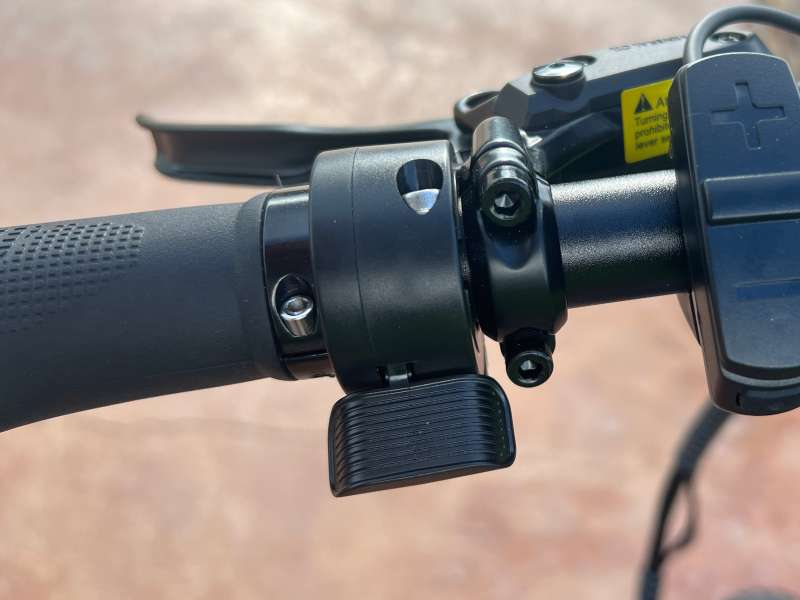
As with all e-bikes, the 2.0 has a throttle to power the bike without pedaling. This e-bike has a lever-style as opposed to a twist-style throttle as on its big brother, the E26. I prefer the lever style as it’s easier to use for me. The throttle on the Engine Pro 2.0 is on the left side of the handlebars instead of on the right which all other e-bikes I’ve reviewed had. The throttle delivered power smoothly as I pressed it. Full throttle takes you quickly up to the maximum of 20 mph (32 kph).
The Engine Pro 2.0 has five levels of pedal assist (PAS) as most e-bikes have (although, the E26 has a setting to increase that to nine for some reason). The PAS can be set to level 0, which disables any assistive power from the motor when pedaling. As mentioned before, the top speed on throttle-only is 20 mpg (32 kph), and the top speed while pedaling is 28 mph (45 kph). The PAS levels apply a little more assistance at each higher level. I rarely used PAS levels 4 or 5, and level 3 was only used to ascend steep inclines.
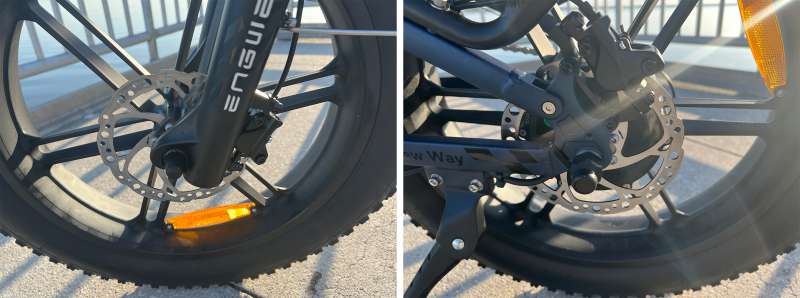
The braking system in the Engine Pro 2.0 exhibited exceptional smoothness and efficiency. Equipped with hydraulic brakes on both the front and rear wheels, featuring dual-piston calipers and 160mm rotors, it delivered great performance. From a speed of about 20 mph, I could bring the e-bike to a complete stop in just 20 feet. Throughout my testing, I never experienced a moment of unease, even during abrupt stops using only the front brakes. The bike’s weight and lower center of gravity, attributed to the battery’s positioning within the frame, prevented any sensation of tipping forward when using the front brakes only. However, relying solely on front brakes for stopping should be avoided as a regular practice.
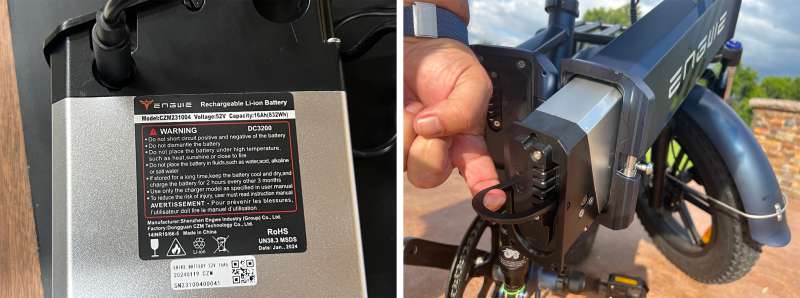
The 2.0 is equipped with a 52V / 16 Ah battery. On the first full charge of the battery, I was able to get about 45 miles (72 km) before I had to recharge. I did a mix of throttle-only and pedal-assisted riding, so this range fell right in the middle of the stated mileage from Engwe. All the other e-bikes I have reviewed were 48V, so I wasn’t sure what to expect with this 52V system. What I did notice, is the power delivery was much quicker than 48V systems. You wouldn’t think that the additional 4V wouldn’t make much of a difference, but it does. From a dead-stop and accelerating to top-speed was quicker on the Engine Pro 2.0 than any other of the e-bikes I’ve ridden.
The battery is “hidden” inside one half of the folding frame of the Engine Pro 2.0. It is locked in place with a pin that is activated with one of the two keys provided with the bike. The keyhole is on the bottom of the frame and covered with the wires running from the front of the bike to the rear. The key is also difficult to turn adequately to unlock the battery and then difficult to remove.
Inside the frame, the battery is sloped downward, and this makes disengaging the locking pin difficult. Also, once the battery is installed, and the locking pin is engaged, the key stays in the bike while you ride. It never fell out, but I always worried it would.
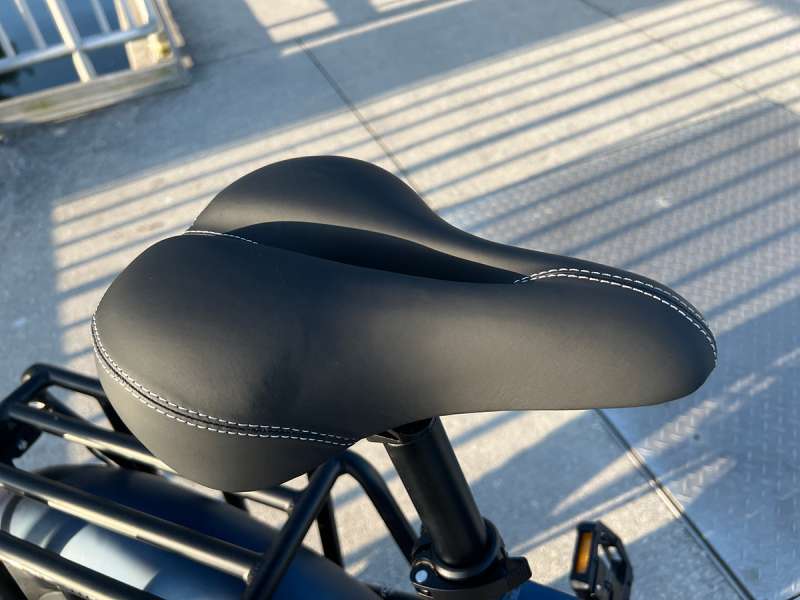
The seat on the Engine Pro 2.0 is thick and comfortable enough for short (less than 2 hours) rides. Longer rides tended to become uncomfortable and sometimes downright painful. I intend on replacing the seat in the very near future. This has been the case on all the e-bikes I have reviewed here on The Gadgeteer.
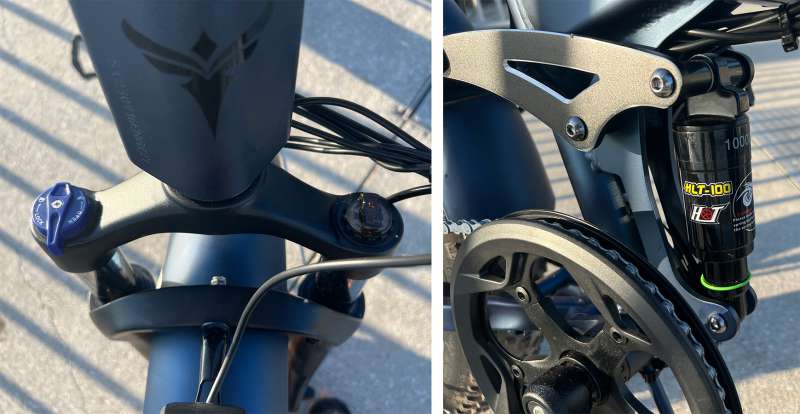
The suspension of this e-bike consists of a front fork with quite a bit of travel, and a mid-frame air-shock and pivoting linkage, known as a Horst-link suspension. The combination of these two components make the Engine Pro 2.0 very comfortable to take off-road and to navigate unevenness of whatever surface you are riding over. The front suspension can be locked out if you ever want to feel your teeth rattle while you ride. The Horst-link air shock is not adjustable as some more expensive e-bikes offer.
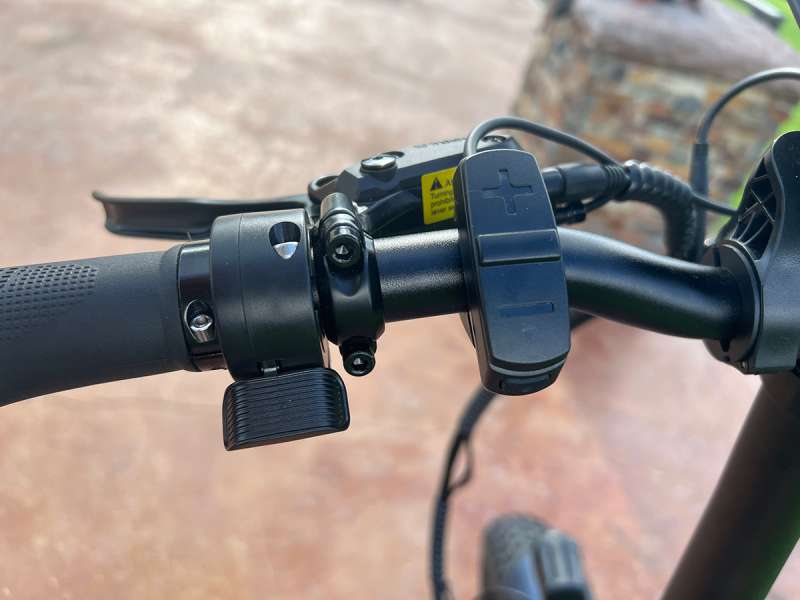
As with most e-bikes, the handlebar is loaded with buttons, levers, and a display. On the Engine Pro 2.0, this is no different. On the left side, you have the front-wheel brake lever, the throttle, and a button bank of 5 buttons. These buttons are for powering on the e-bike, selecting the PAS levels, turning the headlight on/off, and selecting the various modes on the display.
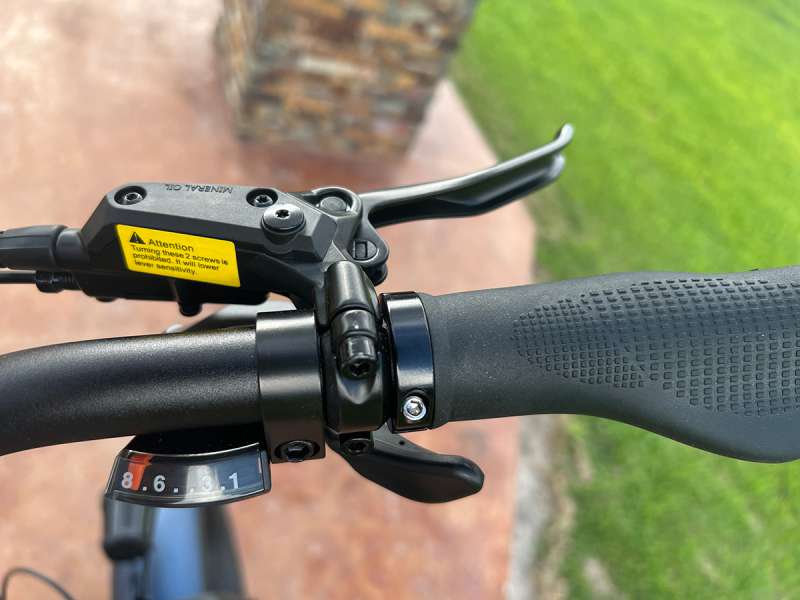
On the right side of the handlebars have the Shimano gear selectors (1-8), and the rear-wheel brake lever.
The handlebar grips are ergonomic rubber grips and are adequately comfortable. They slip on and are held in place with screws to prevent them from twisting. When my hands got sweaty from longer rides, they never got slippery and always felt good in my hands.

The 2.0’s display is a full-color, very bright LCD display. It shows you the current level of the battery with a 5-segment bar), and the speed in either miles-per-hour or kilometers-per-hour. The currently selected PAS level (0-5) is displayed. As well as the trip odometer, full odometer, top speed, and your average speed.
The display will dim when the headlight is being used, and you can view it clearly if wearing polarized sunglasses.
The Engine Pro 2.0 has a folding-style frame and handlebar stem. This feature gives you the ability to make the bike have a smaller footprint (at least in height and length) to be able to store it in a closet or transport it in a trunk or back area of a vehicle.
Although you can fold the 2.0 in half, it doesn’t make it any less heavy. The bike weighs almost 70 pounds without the battery, and over 83 pounds with the battery installed. In an unfolded state, the bike is easy to maneuver. After folding it, it’s a huge lump of metal and battery that is very difficult to handle. I am still not convinced that a folding-style frame is desirable.
Assembly
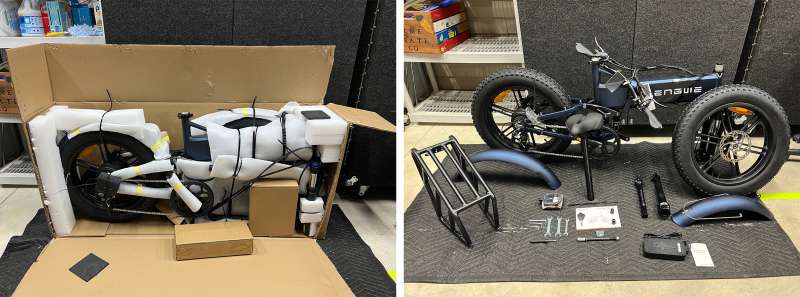
The Engine Pro 2.0 arrived well-packed with tons of padding and zip ties to fill a large trash can, which I did. The instructions and accompanying video walked me through step-by-step of the assembly process. The entire assembly took about 45 minutes.
The only issue I had was in distinguishing the left and right pedals from each other. The pedals have to be installed on the correct side of the bike, and usually, there is an “L” and “R” stamped in the pedals to indicate their corresponding side. It took me 10 minutes to find the barely legible “L” and “R” on the pedals. Maybe stickers would have been better.
The provided tools were all I needed to assemble the bike. After assembly, I left the battery to charge overnight.
What I like about the Engwe Engine Pro 2.0 e-bike
- Size – perfect for my stature
- Power! 52V, 1200w peak motor, 750 Nm torque.
- Very agile with a tight turning radius
- Comfortable to ride
- Torque sensor
- Brakes were quiet
- The paint color and quality are fantastic
What needs to be improved?
- Top speed is limited to 20 MPH (32 KPH) for throttle mode. Most e-bikes can be changed to 28 MPH (45 KPH)
- Pedals were hard to distinguish left from right during assembly
- The motor is a bit noisy
- A bit heavy for a foldable e-bike
- The battery was difficult and cumbersome to remove
Final thoughts
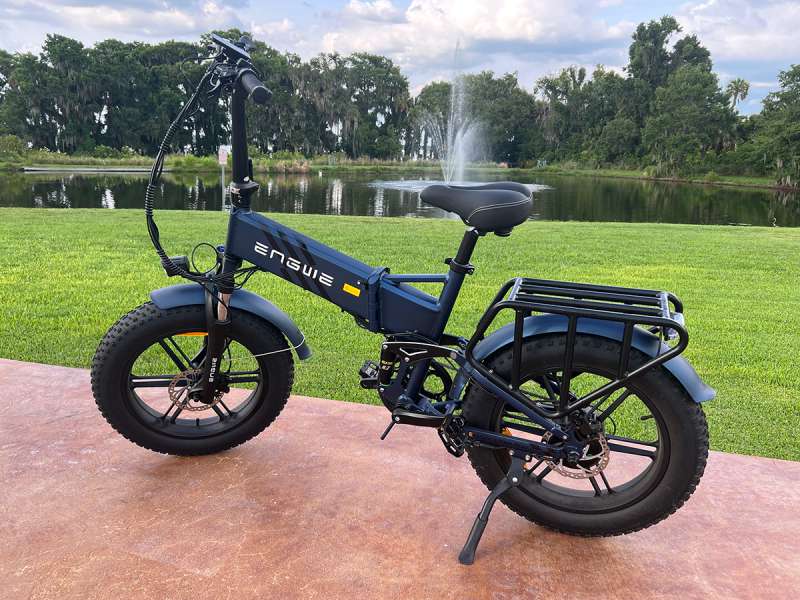
The Engine Pro 2.0 is a great, affordable, folding-style e-bike from Engwe. It is very powerful, with plenty of battery range. Its 20-inch wheels and 4-inch tires make the Engine Pro 2.0 quite a nimble form of transportation and fun. All of the bike components performed perfectly during my 100+ mile review period. Engwe has another great product with the Engine Pro 2.0. I can’t recommend it enough.
Update 8/13/24
We have been informed by ENGWE that a batch of batteries used in this eBike may have a potential safety issue. While the risk is estimated to be very low (one in ten thousand), ENGWE is taking proactive steps to ensure customer safety.
What You Should Do
1. Stop Using the Battery – If you suspect your battery is affected, stop using it immediately.
2. Contact ENGWE – Reach out to ENGWE customer support for verification and further instructions.
3. Follow Disposal Instructions – ENGWE will provide specific instructions for safe battery disposal. However, we recommend consulting local regulations and professional disposal services to ensure safety and compliance.
ENGWE is committed to resolving this issue and will provide a new battery to affected customers. We appreciate ENGWE’s dedication to safety and transparency.
For more information, please contact ENGWE directly.
Price: $1,299.00
Where to buy: Engwe or Amazon
Source: The sample of this product was provided for free by Engwe. Engwe did not have a final say on the review and did not preview the review before it was published.


